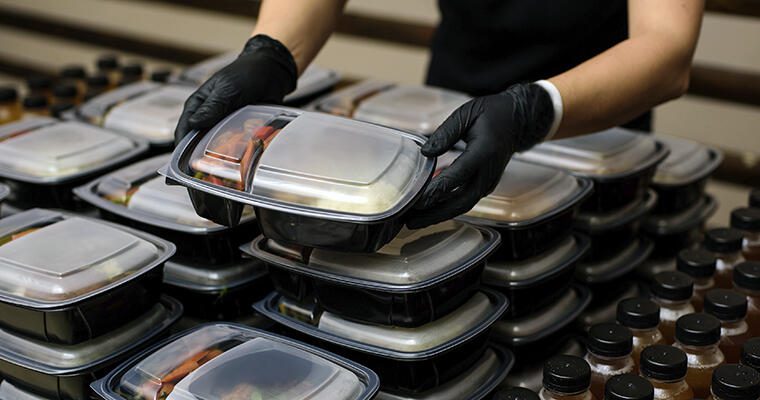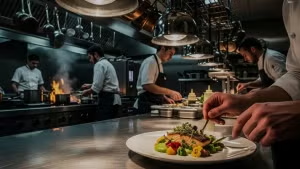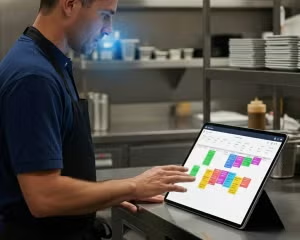Color. Aroma. Selection. A well-stocked self-serve food bar can have as much appeal as a visit to your favorite restaurant. When the popular stop for hospital cafe visitors came to a halt during the pandemic, many operators were eager for their return. The University of Pittsburgh Medical Center made the call to move forward without them.
Before the pandemic, self-serve salad bars, soup stations, bowl builds and sandwich counters were popular, according to Tim Sweitzer, director of food, nutrition and support service analytics for the large Western Pennsylvania healthcare system. UPMC has 95,000 employees and its reach stretches throughout much of the state and into New York and Maryland.
The salad bar alone made up 15-20% of sales. Consumers would add food to their plate and have it weighed at the cash register. The build-your-own flexibility and pay only for what you take option was perceived as a value. Then the pandemic hit.
A change of course for self-serve
When the self-serve options halted for safety reasons, Sweitzer and his team were forced to consider their next moves.
“We noticed the popularity of these bars was starting to decline a bit before the pandemic,” he said. “We think it’s partly generational, as some of our patient and employee base gets a little younger, self-serve was shifting to more grab-and-go.”
Early in the pandemic, grab-and-go was a necessity. As UPMC’s business looked to find new footing, it decided to create a hybrid service model to account for safety, food options, labor stress and technology.
Looking at post self-serve future
Individually wrapped foods. Baked goods like muffins and cookies are purchased pre-wrapped. Salads, soups, sandwiches are assembled and sold covered (or wrapped).
- Downside: Customer selections are limited to available options.
- Upside: Reduced waste, grab-and-go convenience and health/safety control.
Fewer touchpoints. Conveyor-belt toasters, single-use paper sheets for grabbing foods, individual condiment containers and boxed popcorn reduce contact with surfaces.
- Downside: Cost of equipment and arranging space for traffic flow.
- Upside: Allows self-serve action and choices while maintaining safety protocols.
Behind the line service. When it comes to soup, salad and sandwich production, these services have been moved behind a station to be assembled by a staffer.
- Downside: The person working the salad bar adds an assembly task. Demand for salads and sandwiches is so consuming, they must alternate days and guests must learn the cycle.
- Upside: Better staff-guest communications. “What we’ve found out is that we’re able to interact with guests that we never talked with before—we’re getting closer to customers and providing better customer service,” Sweitzer said.
More control. Backing away from self-service makes it easier to maintain food temperatures, monitor inventory and know how food is being used.
- Downside: A person must get used to a new role if they’ve never worked on a line before.
- Upside: With an associate in charge of a station, waste is dramatically reduced, saving money and helping to manage supply chain challenges.
Technology-friendly service. Online ordering, pickup and delivery will be part of the future for healthcare foodservice, Sweitzer said, and moving away from self-serve clears a path.
- Downside: Expansion won’t happen all at once. “We’re installing mobile ordering/mobile pay at our Children’s Hospital Starbucks right now,” he said. “For our bigger cafeterias, we’ll be partnering with our point of sale system, so it will take time.”
- Upside: Staffers will one day be able to order from their desks or units and schedule pickup or delivery. Patients could order food trays using similar technology.
[subhead] Many possibilities ahead
The pandemic changed the perception of healthcare foodservice for UPMC, Sweitzer claims. The food and nutrition department was among the healthcare heroes—an essential business that took care of patients, doctors, nurses and staff on the front lines.
“Many of the people we served are not just associates, they are repeat customers,” he said. “Changing from self-serve improved things for us because we learned how we were taking care of people.”
Next up, he said, is thinking of ways to expand branded concepts and use technology like heated cabinets for rotisserie chickens that staff and guests can order to take home.
“The pandemic has given us a good kick to get working on these pieces. It’s a way of life now. People are demanding it. You have it in your personal life, why not in your work life?”












